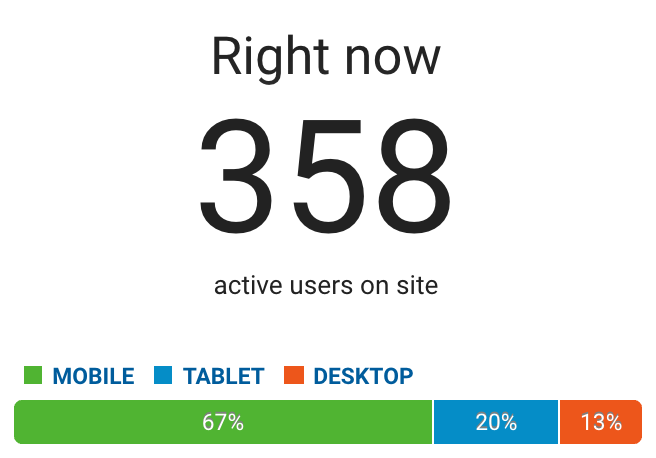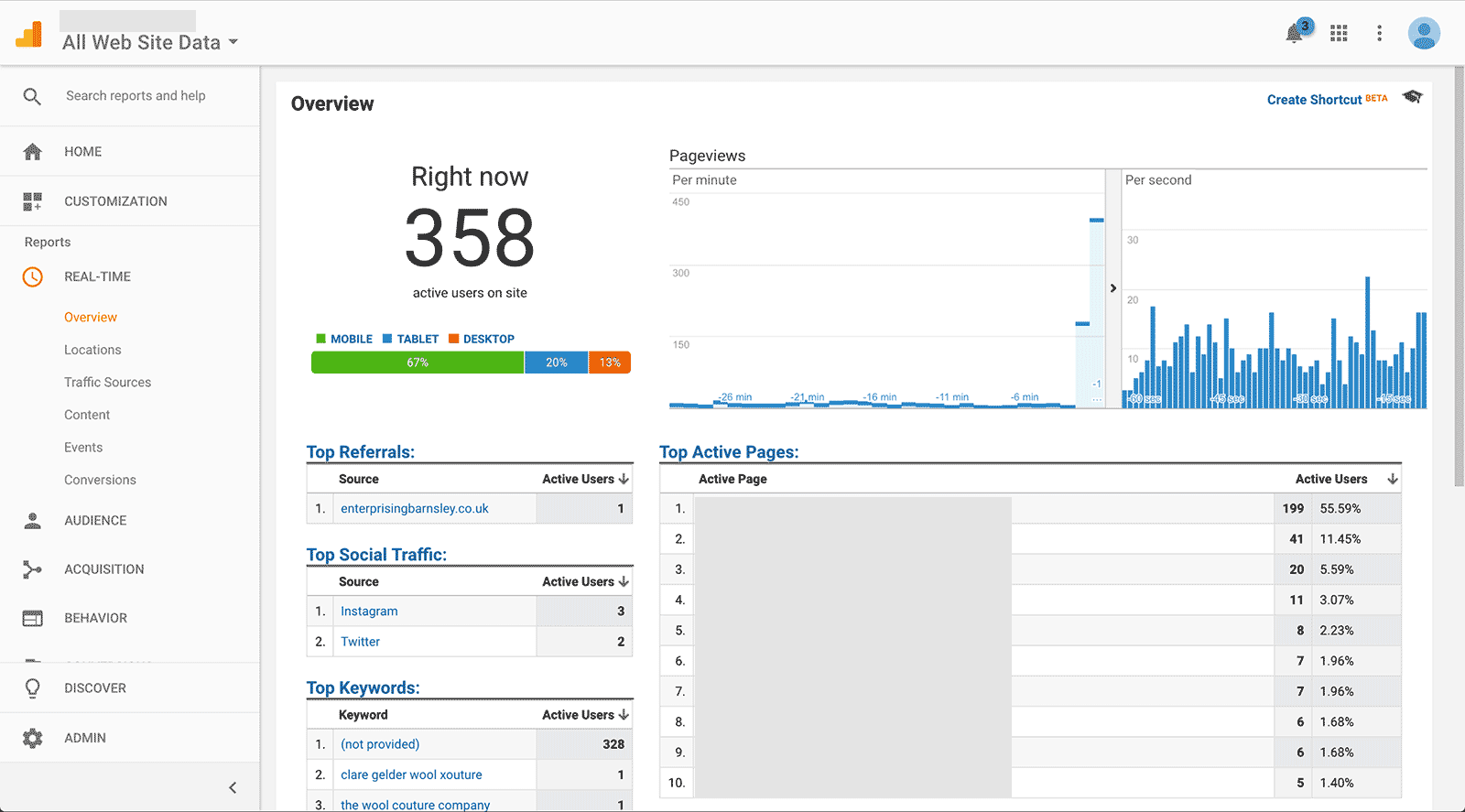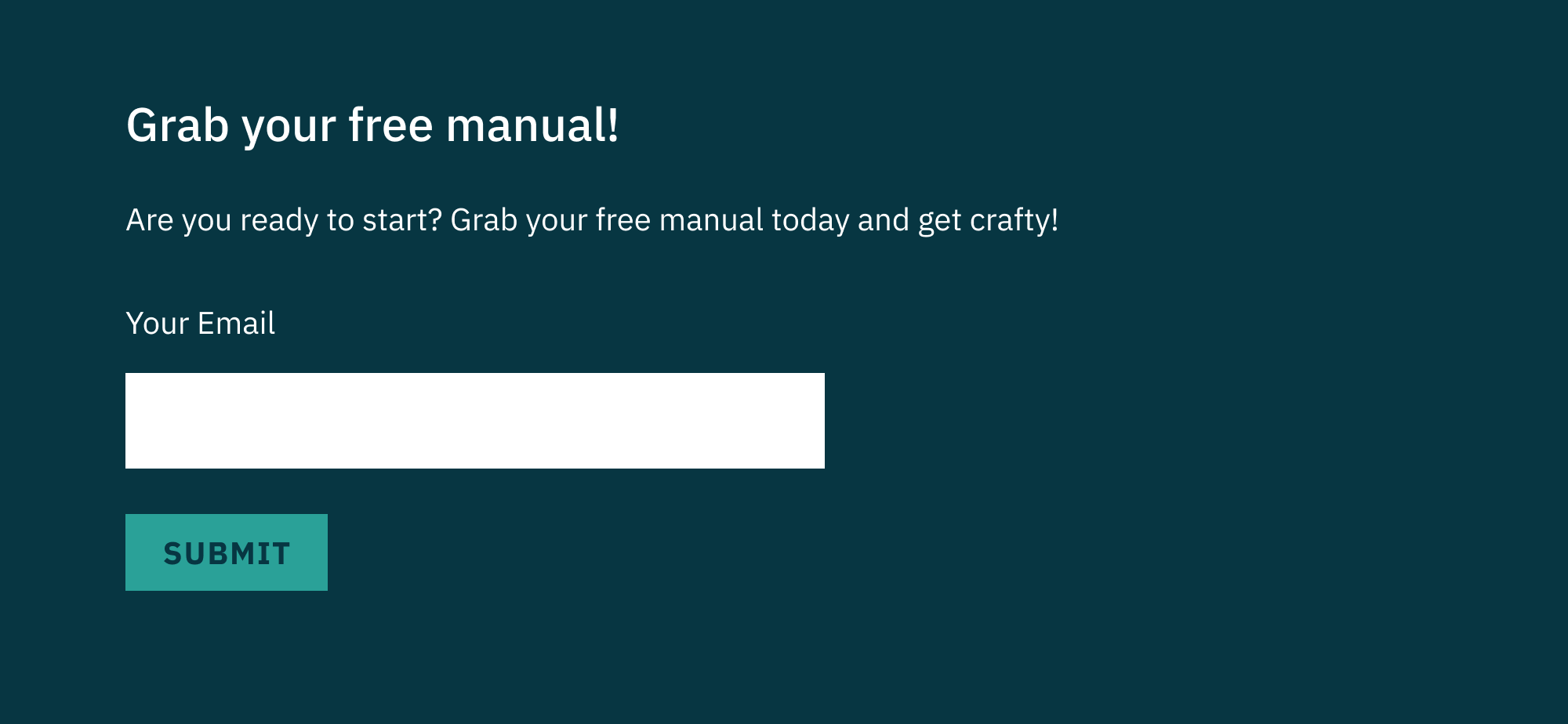What does appearing on TV’s Dragons’ Den do to your web traffic and social media?
Website Design and Development • 14 minute reading time
This article is part of a series discussing How to handle more traffic to your website.
One of our clients was once on BBC’s Dragons’ Den. I’m being vague — purposefully so — and I’m releasing this article some years later, anonymised. Our client didn’t want to be part of this article, but I still think the analysis will be very useful for some digital agencies, so I’m releasing it. Our client will be referred to as The Client throughout this.
We’d been working with The Client for over a year, and we’d managed their website, designed and launched a new website (the new one that appeared on Dragons’ Den) and we’d helped them with their digital marketing and graphic design.
Our biggest challenge yet came when they appeared on Dragons’ Den. The Client did really well, and it was amazing to see. Whilst The Client was on the telly getting questioned by the Dragons, we were sat in our studio in sunny Barnsley monitoring the website.
How we prepared for the traffic
Before we even knew any results, we needed to prepare for the traffic. I started by doing what we all know best: I Googled it. I analysed how much traffic we could expect.
From the many articles online, it looked like we should have expected anything from 5,000–10,000 users to hit the website all at once. We all knew it could be a lot of traffic, so we prepared for the worst.
We knew we’d need a scalable web hosting solution: something that would allow us to expand its capacity if the web server started getting much more traffic than we expected. For that, we knew we’d need to go for a cloud hosting solution. There’s several thousand options for cloud hosting out there (the most popular being Amazon’s), but we liked how Digital Ocean worked, and settled for that.
Once we’d got the Digital Ocean solution setup, we tested it by sending lots of traffic to the site. We needed to be confident that when it came to 8pm on Sunday night, the server would hold up to the undeniable battering it was about to take.
How the website traffic was affected by the TV appearance
When it came to 8pm on Sunday, things started very calm.
The site was averaging 2–5 users at any one time, just as it had been doing for the past month.
The Client had the premier spot on Dragons’ Den, so at about 20:45, everything was nice and steady with the website.
Then at 20:47, things started change. The stats shot up from 5 to 358.

For the next 13 minutes, things went a bit mental.

We were all hands on deck at this point. The website stayed online because we had the website cached from two different places, but it was starting to get slow. We finished off at 21:02 with 2610 concurrent users.
Yes, that’s 2610 people all using the site at the same time. It was a massive amount of traffic to the website, but we coped with a lot of preparation.
What happened next though surprised us even more.
The next 4 hours
Whilst we knew we were going to get a large influx of users to the website within a 10 minute period, we’d expected the traffic to start dying off pretty quickly. We didn’t expect the traffic to sustain for the next four hours.
For the next hour after Dragons’ Den aired, we were still getting 500 users on the website at any one time. We couldn’t believe that the traffic was continuing, and people were spending a long time on the website.
The web traffic stats for the day of Dragons’ Den
On the Sunday September 3rd 2017, the site got 78,465 page views, and 11,203 users. Our average session duration was 4 minutes, which was fantastic. People were browsing the website, considering the products, and more importantly: buying things.
Can you tell which bit of these stats correspond to when The Client was on Dragons’ Den?

To compare stats with a typical day on The Client’s website, Friday September 1st 2017 garnered 2,215 page views and 386 users.
With The Client being on Dragons’ Den for 10 minutes, the site’s traffic was up by over 3500%. Not a bad traffic increase for 10 minutes airtime.
As for sales, The Client’s sales were up by 4000% on the day of the appearance as well.
I was incredibly surprised by the traffic boost. I (rather foolishly) expected 7500 users on the website at once during the slot, but I was still surprised to see 2600 users all using the site at the same time. It wasn’t just that bit that surprised my though, it was the level of sustained traffic for the next four hours as well.
The surprises weren’t over yet though.
The day after Dragons’ Den (and the day after that)
On Monday, we fully expected everything to have died down and gone back to normal. We expected the boost of web traffic to be brief and brutal, and for things to quickly return to normal service. That didn’t turn out to be the case.
It appears that most people decided to come back to the The Client’s site the day after and make their purchases.
When you think about this logically that does make sense: lots of people were trying to use the site during Dragons’ Den and would have experienced a bit of slowness due to the hammering the website was taking.
The day after people could comfortably browse the site in their own time and purchase at their own leisure.
They came back to the website in droves, and purchase leisurely they did.
Whilst sales were up by 4000% on the day of Dragons’ Den, sales were up by a whopping 5000% the day after. The Client closed out Monday 4th September with their best sales day ever through the website.
The website received about 150–200 people on the site at any one time all day on Monday.
On the Monday September 4th 2017, the site got 51,369 page views, and 7,979 users. The traffic was quite a bit less than the day of Dragons’ Den, but the amount of sales and actions people were performing through the website were significantly higher.
We were still seeing a higher-than-average level of traffic on Tuesday too, with 24,978 page views and 4,184 users throughout the entire day. These were still converting to orders too. This graph of the last couple of days shows you the spike of the Dragons’ Den appearance, followed by the (much slower than expected) decline back to normality.

A summary of all the web traffic over Sunday, Monday and Tuesday
To remind you of the traffic over the last 3 days, here’s what we experienced:
- On Dragons’ Den Day: Sunday September 3rd 2017, the site got 78,465 page views, and 11,203 users. Sales up by 4000%.
- On Monday September 4th 2017, the site got 51,369 page views, and 7,979 users. Sales up by 5000%.
- On Tuesday September 5th 2017, the site got 24,978 page views and 4,184 users. Sales up by 3000%.
As you can see, the traffic you receive during the initial slot you get on television might boost your traffic hugely, but if you have a product that you’re selling through your website, you should expect a massive increase in sales not only on the day of your appearance, but at least on the following two days as well.
We’ve seen a ripple effect throughout the rest of the marketing channels too.
Let’s talk about email marketing next.
Email marketing
- 19 subscribers on our lead magnet before we started
- 96 after an hour
At the last minute on Friday we had an idea. We discussed setting up a Lead Magnet with The Client: essentially giving away something free through the website in exchange for a customer (or potential customer’s) email address. It was an idea I’d been trialling with a few other websites and I’d received good conversions from it.
It was — and still is — an extremely simple lead magnet. Here’s what it looks like on the site.

Within hours of us adding this to the website, 19 people had signed up to receive their free manual. Once we saw this we knew we were onto a good idea.
After the weekend, the lead magnet now has 374 subscribers, and it’s increasing every day. It’s surpassed the amount of standard website subscribers in just 3 days.
After a week, the subscribers had doubled to way over 600.
Our standard website subscribers list has also increased massively in 3 days too, going from 66 to 235.
It’s hard to see from Mailchimp’s stats as they’re not incredibly effective, but I’d put an educated guess together and say that The Client’s total email subscriber list has increased by about a 1000 in 3 days.
A summary of the email marketing stats
I was surprised the most by how well the lead magnet performed, and still is performing. By implementing this ahead of the traffic rush from the television appearance, we’ve managed to capture hundreds more email addresses from interested buyers than we otherwise would have.
I’d like to continue increasing this over the next few months, and our first step will be to create a dedicated landing page for the lead magnet. This will allow us to effectively drive paid traffic to it to make sure it converts as well as it should, and create very specific Facebook Ads to drive the traffic.
If you currently aren’t giving away anything free on your website in exchange for an email address, consider this a very useful tactic to increase your email marketing list.
It only needs to be a simple PDF, or a help guide, or something else small. It doesn’t have to be something difficult to put together, but it will — as our results have shown — undoubtedly increase your conversion rates on your email marketing signups.
On the day of Dragons’ Den, Twitter generated 375 visits to the The Client’s site. On Monday, it generated 125, then Tuesday it generated 77. Despite a lot of people talking about The Client on Twitter, it didn’t send us impressive amounts of traffic to our website.
There was an impressive amount of interaction and buzz generated on the day of Dragons’ Den though. As so many people do these days, people sat and watched Dragons’ Den then started tweeting about what they were seeing. That lead to the The Client’s twitter account receiving 245 likes and 79 retweets within a couple of hours.
We also saw The Client’s Twitter follower account increase too. I’ve added Saturday into the list so you can compare.
- Saturday: 1661
- Sunday (Dragons’ Den Day): 1881
- Monday: 1955
- Tuesday: 1980
- A total increase of 319 followers in 3 days.
A summary of the Twitter stats
Whilst 319 extra followers might not sound that impressive as a raw number, we were incredibly impressed by this. That’s a massive boost to The Client’s Twitter following, but more importantly, it’s a highly relevant increase in audience.
We can be sure everybody who followed The Client’s Twitter page in those few days followed because they saw The Client on Dragons’ Den, meaning they’re very interested in what The Client has to say, and their products.
We also saw a massive increase in engagement and general interaction, such as retweets, quoted tweets and replies increasing rapidly. Overall it’s been an impressive boost.
On the day of Dragons’ Den, Facebook generated 248 visits to the The Client’s site. On Monday, it generated 460, then Tuesday it generated 569.
As you can see the traffic continued rising and rising from Facebook. Some of this was from a Facebook Ad we setup prior to The Client appearing on Dragons’ Den.
We setup an advert that would target people who visited the website from Sunday onwards, meaning that anybody who visited the site because they saw The Client on Dragons’ Den would see an advert in their Facebook timeline over the following days.
This is what the advert looked like:

This lead to a lot of highly relevant traffic being sent to the website which converted very well. The Client’s Facebook page also received a nice boost in likes. Again, I’ve added Saturday into the list so you can compare.
- Saturday: 1959 page likes
- Sunday (Dragons’ Den Day): 2371
- Monday: 2592
- Tuesday: 2736
- Added 777 new likes in 3 days
A summary of Facebook stats
Facebook converted better and also sent more traffic to the website than Twitter did, without a doubt. This was also helped by our Facebook Ad we setup to retarget the people who’d visited the site because they’d found The Client on Dragons’ Den.
Facebook Ads are incredibly effective, and I consider it my favourite advertising platform on the planet right now. If you’re making a media appearance such as appearing on TV, I’d highly suggest doing the same as what we did: setup your Facebook Pixel to track users visiting your website, and hit them with an ad in Facebook a day after they originally heard about you.
Google Ads
The other really important advertising platform is Google Ads. This one has been around much longer than Facebook Ads, and Google practically invented the digital advertising game.
We’d been running an Google Ads campaign for some time prior to the Dragon’s Den appearance to point anybody searching for “The Client” towards our website.
We knew it was important we had this running during the TV appearance so we could capture all of the traffic that we didn’t get with natural search engine rankings.
Google Ads sent a good level of traffic to our site too.

Our cost per click was extremely low (and actually half the cost of Facebook Ads), and the amount of pages that people were viewing during each visit showed us that the right kind of traffic was landing on the The Client’s website.
There’s definitely room for improvement for the conversion rate, and this is what we’ll be working on next.
A summary overall
We’re still a little shellshocked by the amount of traffic that a tiny 10 minute slot on a 3 million views TV show has provided the website, and subsequently all other marketing channels.
I’d read lots of articles similar to this one just before The Client appeared on Dragons’ Den, and I’d seen mixed reports of how much traffic to expect to a website.
The figure I saw bandied around was 10,000 viewers to your website at once, but we didn’t see this level of traffic. We still saw a very large 2600 users at once which got us sweating, but it was the effect of that initial traffic over the following days on sales and social media reach that surprised us the most.
Just a couple of things to remember if you’re appearing on a major TV show:
- Make sure your website can handle at least 2600 users at once browsing. That’s not in total over a period of time, that’s concurrently. That means all at once, not one after the other.
- Get your web developers to cache your website, lock it down, and not make any drastic changes in the prior 48 hours to going on TV. You don’t want anything to be broken or to make a bad impression, as these people likely won’t come back to your website again (unless you remarket to them—see next tip).
- Setup your Facebook Pixel to track people visiting your website, then send them an advert in Facebook the day after you’ve appeared on TV to recapture your audience and make sales.
- Setup a Google Ads campaign to capture people searching for your company name. That way you can be sure that everybody will land on your website and not a competitor’s.
- Consider setting up some kind of lead magnet: a free pdf, a free download or product that you can give away to capture an email address from a highly interested user.
- Whilst your site is getting battered from so much traffic, people probably won’t be able to browse your website as well as they’d like to. They will come back the day after though, so that’s the prime time to run your Facebook Ads and make sure you’re prepared for an increase in orders.
- If your website isn’t an ecommerce website, try and put something on there that will prompt the user to give you their details for a later purchase. If they’re interested, they will come back when they need you. See tip 5.

Craig Burgess
Craig is Genius Division's creative director. At weekends, he likes to strangle and grapple fellow Brazilian jiu-jitsu enthusiasts throughout the country. In his down time, he peruses the internet's finest cat videos.
